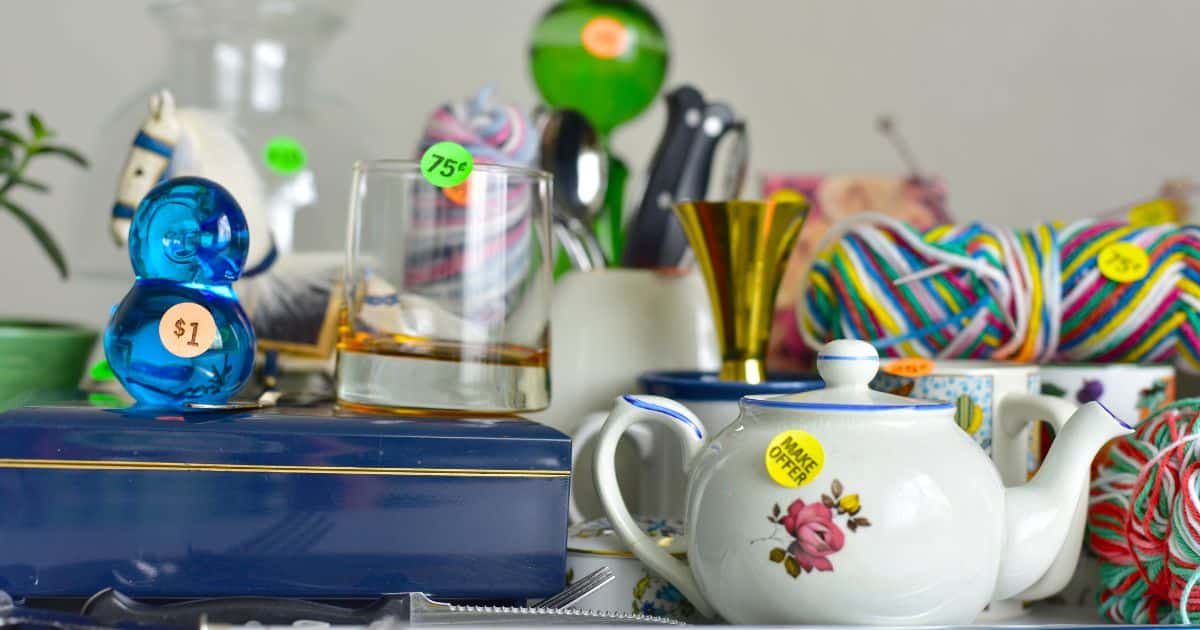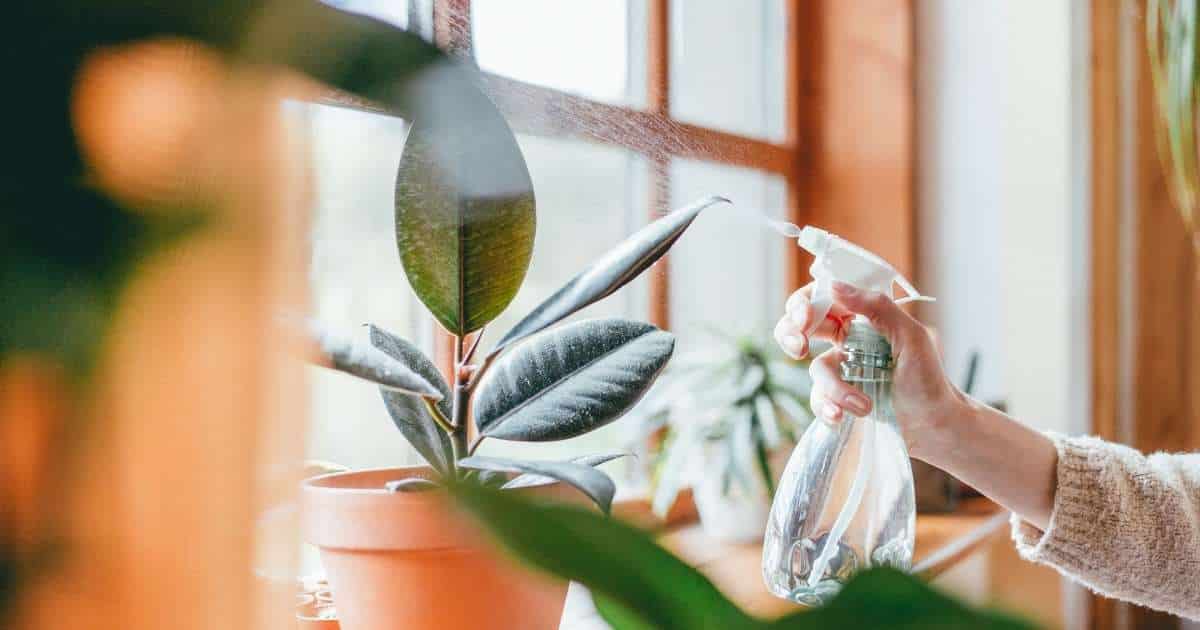Need a Humidifier? The 10 Best Humidifiers for Plants
Welcome, fellow plant lovers! If you’re on a mission to keep your houseplants happy and healthy, you’re in the right place.
Indoor gardening can be a rewarding adventure, but it comes with challenges, and one of the big ones is maintaining the perfect humidity level for your plant babies.
In this guide, The Best Humidifiers for Plants, we’ll explore why plant humidifiers are a game-changer for an indoor garden, the different types of plant humidifiers, and how to pick the best humidifier for your space to keep plants thriving.
Let’s jump in!
This post may contain affiliate links. Read disclosure here
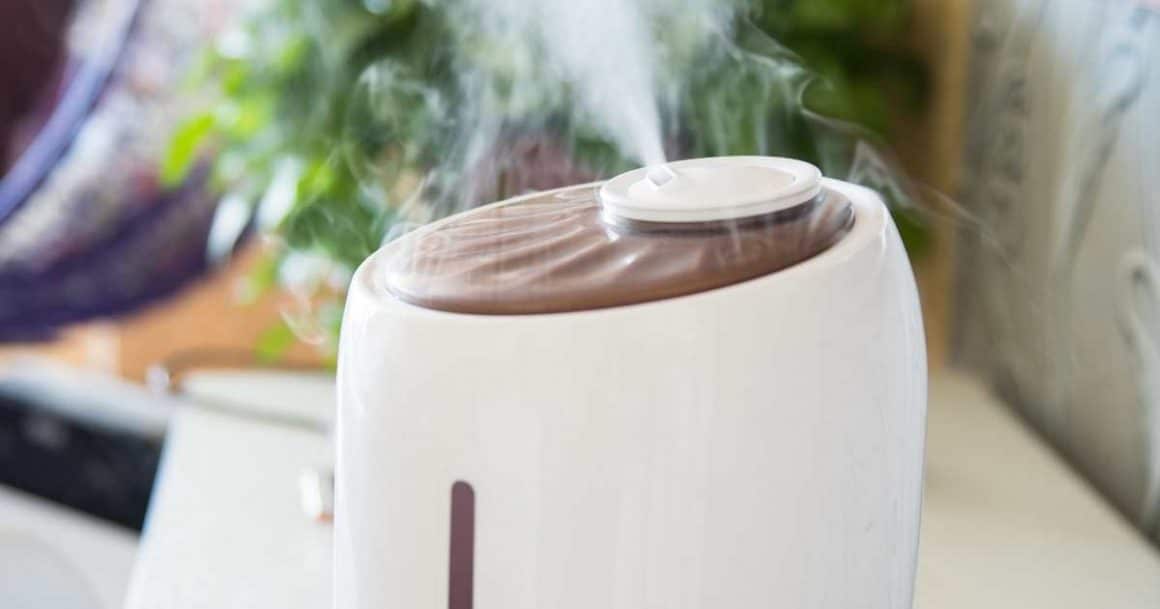
The Benefits of Humidity for Plants
Maintaining the proper level of humidity in your home can benefit not only your plants but also your overall health and well-being.
Increasing humidity can promote plant growth, reduce respiratory issues, and create a more comfortable indoor environment for you and your family.
Plants and Humidity
Houseplants, especially tropical ones, thrive in humid environments.
The Benefits of Running a Humidifier Indoors:
Promotes plant growth: Plants thrive in environments with 40-60% humidity. Running a humidifier can help maintain these levels and encourage healthy growth.
Reduces plant stress: Low humidity can cause plant stress, leading to wilting, brown leaves, and slow growth. A humidifier can help prevent these issues by maintaining optimal humidity levels.
Prevents pest infestations: Many pests, such as spider mites and mealybugs, thrive in dry environments. Running a humidifier can help prevent these pests from infesting your plants.
Improves air quality: A humidifier can help improve the air quality in your home which can cause respiratory problems and dry skin.
Reduces static electricity: Dry air can also cause static electricity, which can be damaging to plants. Running a humidifier can help reduce static electricity and keep your plants healthy.
The Desired humidity for plants
Ah, today’s golden question: What’s the perfect humidity level for houseplants?
Different plants have different preferences when it comes to room humidity. But here’s a rule of (green) thumb:
Most houseplants are pretty content in a humidity range of 40% to 60%.
The ideal humidity for houseplants is 40-60% higher than the humidity found in our homes, especially during the winter or in dry climates. (source)
Now, that’s a pretty broad range, right? Here’s why:
- Tropical Plants: Your humidity-loving tropical plants, like ferns or orchids, are all about that 60% mark. They want to feel like they’re on a lush island.
- Average Joes: Many common houseplants, your pothos or snake plants, are cool in the 40% to 50% range. They’re like the chill, laid-back friends who adapt to your environment.
- Desert Dwellers: Then you’ve got your desert cacti. They’re happy with humidity in the 30% to 40% range or even lower. These guys are used to the arid desert and are all good with low humidity.
It’s not just about hitting that magic number.
It’s about maintaining a consistent humidity level. Sudden drops or spikes can stress your plants out. Long story short, aim for that 40% to 60% range but always check the specific needs of your plants.
They’ll let you know if they’re happy or not. Keep reading to learn about symptoms of low room humidity.
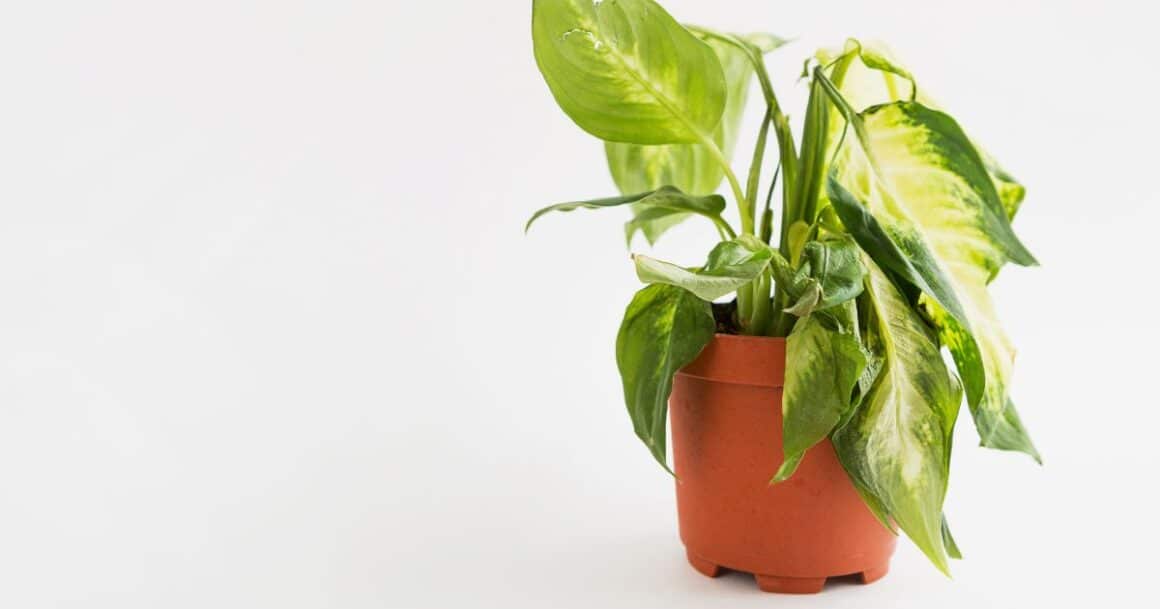
Symptoms of Low Humidity for Houseplants
Overall, it is essential to monitor the humidity in your home and increase humidity if your plants show signs of stress due to low moisture.
All houseplants will benefit from higher humidity, especially in dry climates.
Here are some signs your leafy pals might show when the humidity’s too low:
- Crispy Leaf Edges: If your plant’s leaves start looking all crispy and brown at the edges, it’s often a sign of humidity trouble. They’re basically telling you, “Hey, we’re thirsty, and the air’s too dry!”
- Yellowing Leaves: Yellow leaves that drop like confetti at a New Year’s party could be a cry for help. Dry air can stress your plants out, and they might shed leaves to cope.
- Slow Growth: If your plant is in slo-mo growth mode, low humidity could be the culprit.
- Flower Problems: If your flowering plants suddenly stop blooming or drop their buds, humidity could be to blame. They’re like, “Sorry, we can’t party in this dry atmosphere.”
- Pests : Yep, pests love dry air. Low humidity can attract critters like spider mites and mealybugs, which is not a guest list you want at your plant party.
- Curling Leaves: Some plants get all dramatic with their leaves and start curling when humidity is low. They’re trying to reduce surface area to minimize water loss.
- Leaf Drop: When your plant starts shedding leaves, it’s a clear indication that it’s not comfortable with the current humidity levels.
.Related: The Best Plant Care Apps
The Most Popular Humidity Loving Plants
As I mentioned, tropical plants are the most common plants that love humidity. Here is a quick list of some more plants that love humidity.
Ferns – These plants are native to tropical climates and require high humidity to thrive.
Orchids – These exotic flowers are known for their beauty and require high humidity to keep their blooms looking their best.
Calathea – This plant is native to the rainforests of South America and requires high humidity to keep its leaves looking vibrant and colorful.
Prayer Plant – This plant is known for its unique foliage that folds up at night, resembling hands in prayer. It is native to the rainforests of Central and South America and requires high humidity to thrive.
Peace Lily – This low-maintenance plant is known for its beautiful white blooms and ability to improve air quality. It is native to the rainforests of Central and South America and requires high humidity to maintain its glossy leaves.
Peperomia – This plant is easy to care for and comes in various shapes and sizes. It is native to Central and South America and requires moderate to high humidity.
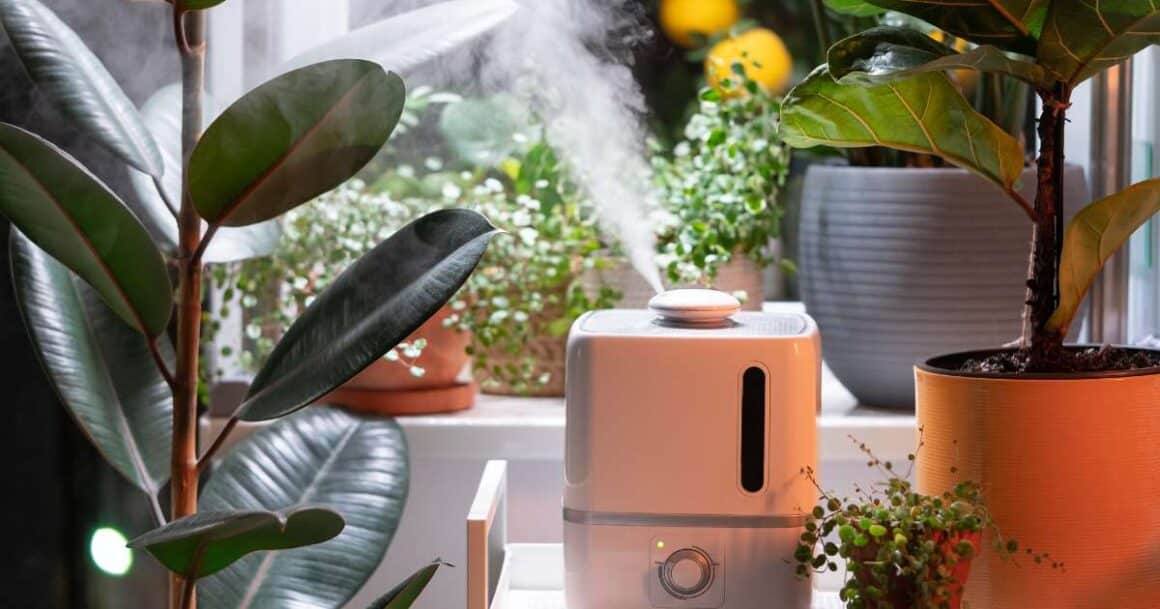
The Main Types of Humidifiers
There are several types of humidifiers available on the market, each with its own unique features and benefits for plants.
From cool mist to warm mist and ultrasonic to evaporative, understanding the differences between these types of humidifiers can help you choose the best option for your plant’s needs.
The most common types of humidifiers include:
Ultrasonic Humidifiers:
Well, ultrasonic humidifiers use some snazzy technology involving ultrasonic vibrations to turn water into a mist. Think of it as a tiny, silent dance party happening inside your humidifier.
Here’s the lowdown on why people dig these:
1. Whisper-Quiet: Seriously, you’ll forget it’s even there. Ultrasonic humidifiers are quieter than a library during a nap. Great for those who can’t stand humming appliances.
2. Energy-Efficient: They won’t suck up your electricity like a vacuum cleaner. These babies are eco-friendly and wallet-friendly.
3. Cool Mist or Warm Mist: You can choose between cool mist and warm mist options. Cool mist is like a refreshing breeze, while warm mist feels like a cozy hug on a chilly day. Your call.
4. Easy to Clean: Cleaning is a breeze. No complicated parts to disassemble, just a quick wipe-down and you’re good to go.
5. Perfect for Plants: Your plants babies will adore the gentle mist these humidifiers provide. It’s like a spa day for your ferns.
Now, here’s the deal – they’re not all sunshine and rainbows:
1. Limited Coverage: They work best in smaller rooms. If you’re trying to humidify your entire mansion, you might want to look into other options.
2. White Dust: Sometimes, they can create a fine white dust from the minerals in your water. But no worries, you can use distilled water to avoid this.
So there you have it – ultrasonic humidifiers. They’re quiet, efficient, and they make your plants and your lungs happy. What’s not to love?
Evaporative Humidifiers
Sure thing! Let’s talk about evaporative humidifiers, the cool, down-to-earth cousins of the humidifier world.
So, what’s the deal with these gadgets? Well, evaporative humidifiers work their magic using a simple and effective concept: evaporation. Here’s how they roll:
1. Wick and Water: Inside an evaporative humidifier, you’ll find a nifty component called a wick or a filter. This bad boy soaks up water like a sponge.
2. Fan Power: Next up, a fan kicks into action. It blows air over that wet wick or filter, causing the water to evaporate into the air as a cool mist. It’s like Mother Nature’s way of saying, “Here, have some humidity!”
Now, here’s why folks dig evaporative humidifiers:
1. Budget-Friendly: These humidifiers won’t break the bank. They’re usually more affordable than their high-tech counterparts.
2. Simplicity Rules: They’re easy to use and maintain. No need for fancy cleaning rituals – just give the wick or filter a rinse or swap it out every once in a while.
3. Cool and Comforting: The mist they produce is cool, which can be refreshing, especially in hot weather. It’s like a mini breeze of relief for your skin.
4. Say No to White Dust: Unlike some other humidifiers, evaporative ones won’t create that pesky white dust because they use natural evaporation.
Now, for a dose of reality:
1. Louder Than a Whisper: While they’re not as noisy as a rock concert, evap humidifiers do have a fan, so they make some noise. It’s usually not a deal-breaker, but it’s worth noting.
2. Limited to Cool Mist: You won’t get warm mist with these. So, if you prefer that cozy, warm feeling, you might want to explore other options.
Warm mist humidifier vs cool mist Humidifier: Which is Best?
Warm Mist Humidifiers
These humidifiers heat water until it becomes steam, then disperse it into the air.
Warm mist humidifiers tend to be a popular choice during the winter months and for cold and flu season but can be more expensive to run and require frequent cleaning.
Warm Mist Humidifiers: These are like the cozy blankets of the humidifier world. Here’s how they roll:
1. Steamy Goodness: Warm mist humidifiers heat up the water in their tanks, turning it into steam before releasing it into the air. It’s like a warm, comforting cloud of moisture.
2. Germ Busters: The warm mist can help kill off some of those pesky germs and bacteria in the water. Think of it as a natural purifier.
3. Soothing for Coughs: They can be particularly soothing if you or your plants have a cough or congestion. The warm mist can help ease respiratory discomfort.
But, hold on to your watering can; there are some downsides to warm mist humidifiers:
1. Energy Guzzlers: They tend to use more energy because they need to heat the water. So, they might not be the best choice if you’re trying to save on your energy bill.
2. Safety First: You’ve got to be careful with warm mist around kids and pets. The steam can be hot, so make sure they can’t accidentally touch it.
Cool-Mist Humidifier
These humidifiers use a fan to blow air over a wet wick or filter, which then evaporates into the air. Cool mist humidifiers are affordable, energy-efficient, and easy to clean.
Cool Mist Humidifiers: These are like a refreshing splash of water on a hot summer day. Here’s the lowdown:
1. Fresh and Cool: Cool mist humidifiers release room-temperature mist into the air. It’s like a cool breeze on a warm day.
2. Energy-Efficient: They’re usually more energy-efficient because they don’t need to heat the water. Wallet-friendly and eco-friendly!
3. Plant-Friendly: Many plant parents prefer cool mist for their leafy pals. It replicates the natural environment for most plants.
But, there are a couple of things to keep in mind in regard to cool mist humidifier:
1. No Germ Zapping: They don’t have the germ-killing powers of warm mist humidifiers. You’ll need to be diligent about cleaning to prevent mold and bacteria growth.
2. Splish-Splash: Sometimes, the cool mist can make things feel a bit damp in the room, so be prepared for that.
Which Type of Humidifier is the best for plants? Warm or cool mist?
Well, it depends on your plants’ preferences and your own comfort. Most houseplants thrive with either type of humidifier.
If you want to mimic a natural environment, go for a cool mist. But if you’re battling germs and want added warmth, warm mist might be your choice.
Let’s go over a few key factors to help you decide which type of humidifier for plants is the best for you.
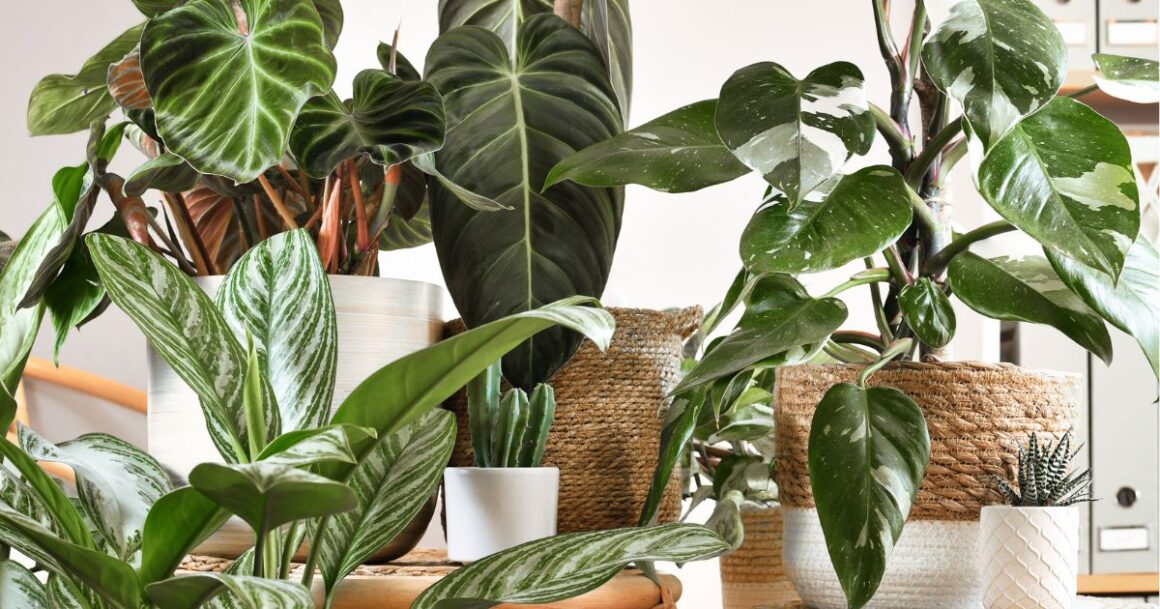
Factors to Consider When Shopping for a Humidifier
When shopping for a humidifier for your indoor plants, there are several key factors to consider, such as the size of the water tank, the type of humidifier, the level of noise, and the presence of a humidity gauge or sensor.
Here are some factors to consider before making your purchase:
Humidity levels:
Some humidifiers also have a built-in sensor or humidistat that automatically adjusts the humidity levels based on the current readings.
This feature allows you to monitor the humidity levels in your home and change the humidifier accordingly to ensure optimal levels.
With a built-in gauge or sensor, you can easily track the humidity levels and adjust without purchasing a separate hygrometer.
Room Size
When choosing a humidifier for a specific room, it’s important to consider the size of the room and the capacity of the humidifier.
A general rule of thumb is to choose a humidifier that can humidify a room that is slightly larger than the actual room size.
For example, if you have a room that is 300 square feet, you should choose a humidifier with a capacity of at least 350 square feet.
Water Tank Capacity:
One of the critical factors to consider before choosing a humidifier for indoor plants is the water tank’s size—the water reservoir’s size and the humidifier’s run time needing a refill.
I recommend choosing a humidifier with a large water tank capacity which is recommended for larger rooms and to avoid frequent refills.
Noise level:
This is especially true if you plan to use it in a bedroom or quiet space where the noise level is most important.
An Ultrasonic humidifier can be a good option if noise is an issue, as they are generally the quietest option.
*Check the decibel rating before purchase if noise is a concern.
Maintenance:
Regular maintenance is required to maintain a humidifier properly and avoid bacteria and mold buildup. Choose a humidifier that is easy to clean and maintain.
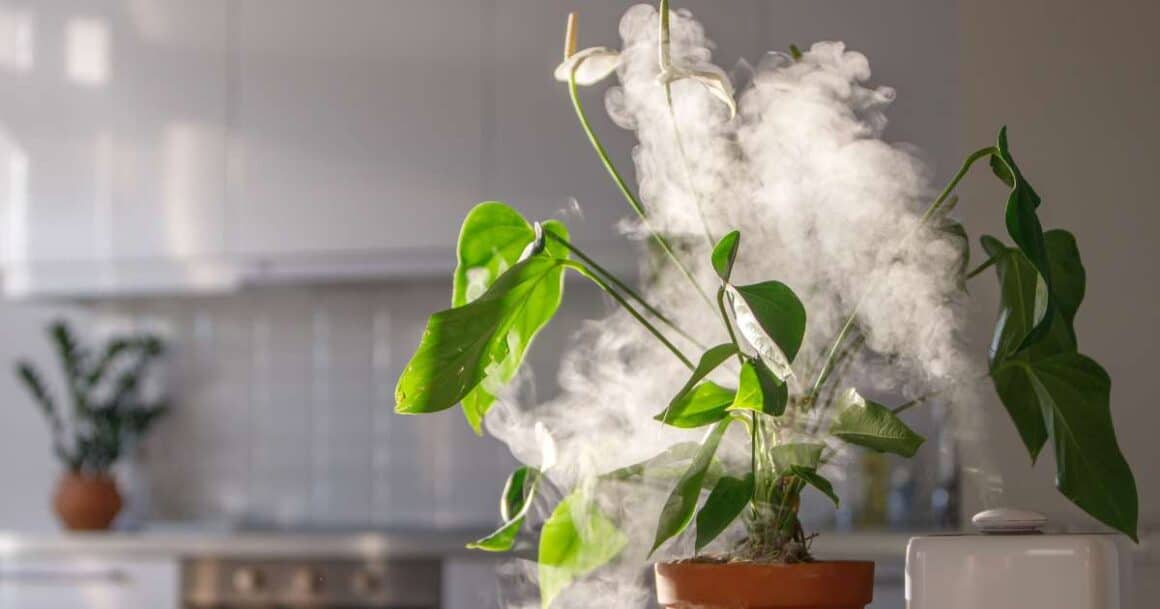
The 10 Best Humidifiers for Plants
Ok! Now that I’ve gone on and on about humidifiers or plants-her is my carefully curated list of the best humidifiers for plants and people alike!
LEVOIT OasisMist Smart Cool and Warm Mist Humidifier
The LEVOIT OasisMist Smart Cool and Warm Mist Humidifier is a high-tech option for indoor plant enthusiasts.
This humidifier features cool and warm mist settings, making it suitable for year-round use. It also has a large tank that can hold up to 1.5 gallons of water, meaning fewer refills are needed.
The OasisMist is also Wi-Fi enabled, allowing you to control it with your smartphone or voice commands through Amazon Alexa or Google Assistant.
It also has a built-in humidity sensor that automatically adjusts the moisture levels in the air for optimal plant growth.
Its sleek design and advanced features make it an excellent option for those looking for a high-tech and efficient humidifier for their indoor plants.
LEVOIT Classic300S Ultrasonic Smart Top Fill Humidifier
This humidifier features a top-fill design, making it easy to refill the tank without removing it from the base. It also has a large water tank capacity of 6 liters, providing continuous mist for up to 60 hours.
The Levoit Classic300S is Wi-Fi enabled and can be controlled using the LEVOIT app, which allows you to adjust the mist level, set a schedule, and monitor the humidity levels in your home.
It also has a built-in humidity sensor that automatically adjusts the mist output to maintain optimal humidity levels for your indoor plants.
It has a 360-degree nozzle and warm mist function for added comfort during cold winter.
Honeywell Cool Moisture Humidifier, Medium Room
The Honeywell Cool Moisture Humidifier is medium-sized with UV technology and a wicking filter to help treat the water and capture minerals to keep them out of the air for a cleaner mist.
With a 1-gallon water tank, this humidifier can run for up to 24 hours on a single fill, making it ideal for use in medium-sized rooms.
The filter-free design ensures it’s easy to clean and maintain, while the adjustable humidity control allows you to set the perfect humidity level for your plants’ needs.
This humidifier is super quiet, making it an excellent choice for bedrooms and nurseries.
Everlasting Comfort Ultrasonic Cool Mist Humidifier
This humidifier uses ultrasonic technology and features a large water tank with a run time of 50 hours or more! It’s got adjustable mist levels, an led light, and a built-in oil tray for essential oils.
The large humidifier is nearly silent (less than 35 dB), making it the best choice in the bedroom, baby nursery, office, or other spaces where noise levels must be kept low.
The modern design features a dial to control auto-turn-off, a LED nightlight, and a water-level window allowing you to see how much water is left in the tank.
We have had this humidifier in our home for a few months, and I love it! It comes in both black and white.
The Elechomes Humidifier for Bedrooms
The Elechomes Humidifier is a large humidifier with sleep mode have a large water tank capacity, providing up to 40 hours of continuous mist.
It also has a built-in sensor that automatically adjusts the cool mist output to maintain optimal humidity levels for your indoor plants.
The Elechomes Humidifier is perfect for large rooms and spaces, as it can humidify up to 750 sq ft.
The sleep mode feature ensures the humidifier operates quietly throughout the night, making it ideal for use in bedrooms or nurseries.
The humidifier also has a 360-degree nozzle that allows you to direct the cool mist in any direction.
With its sleek design and advanced features, this humidifier is an excellent option for anyone looking for a high-quality humidifier for their humidity-loving plants and people! 🙂
AquaOasis Cool Mist Humidifier
The AquaOasis Cool Mist Humidifier is a budget-friendly option for indoor plant enthusiasts.
This humidifier features a large water tank that can hold up to 2.2 liters of water, providing continuous mist for up to 24 hours.
It also has a 360-degree nozzle, allowing you to direct the mist in any direction. It’s ultra-quiet and energy-efficient, making it a great option in bedrooms or nurseries.
It also has an automatic shut-off feature that turns the unit off when the water level is low or the tank is removed.
Additionally, this humidifier for plants has a built-in filter that helps remove impurities from the water, ensuring the mist is clean and pure.
This humidifier may not be the cutest on the block, but it’s got great features and the price point is pretty awesome.
Lacidoll 4.2 Gal Tower Humidifier for Large Rooms or Whole House
The Lacidoll 4.2 Gal Tower Humidifier is an option for those who need a humidifier that can cover a large area.
This humidifier has a large water tank capacity of 4.2 gallons, providing up to 30 hours of continuous mist.
It also has a built-in humidity sensor that automatically adjusts the mist output to maintain optimal humidity levels for your indoor plants.
The Lacidoll Tower Humidifier is perfect for large rooms, covering up to 500 square feet.
It has a sleek and modern tower design that complements any room decor and is easy to clean and maintain.
The humidifier also has a 360-degree nozzle that allows you to direct the mist in any direction, ensuring that your plants receive the necessary moisture.
This humidifier is an excellent humidifier for plants and humans alike!
Pure Enrichment MistAire Silver Ultrasonic Cool Mist Humidifier
The Pure Enrichment MistAire Silver Ultrasonic Cool Mist Humidifier is a sleek and stylish option for indoor plant enthusiasts.
This humidifier features a compact design perfect for a small room while providing up to 16 hours of continuous mist.
It has a 360-degree nozzle that allows you to direct the mist in any direction and is ultra-quiet, making it ideal for use in bedrooms or nurseries.
It also has an automatic shut-off feature that turns the unit off when the water level is low, or the tank is removed.
Additionally, the optional night light adds a soothing glow to any room.
Perfect humidifier for plants in small rooms. Comes in white and green.
Movtip Portable Mini Humidifier
The Movtip Portable Mini Humidifier is a small and compact humidifier that is ideal for use in small spaces such as offices, bedrooms, and cars.
This humidifier is designed to be portable and easy to use, with a USB cable for charging and a 200 ml water tank that provides up to 8 hours of continuous mist.
The Movtip Portable Mini Humidifier uses ultrasonic technology to produce a fine mist that helps to increase humidity levels and reduce dry air.
It also has a built-in LED light that can be used as a nightlight or to create a relaxing ambiance.
While this humidifier is small, it’s mighty! It’s under $20 and comes in several colors!
Vicks Warm Mist Humidifier
This classic warm mist humidifier is an excellent option, especially during the cold and flu season.
This humidifier uses a heating element to boil water and create steam dispersed into the air.
It also has a medicine cup that can be used with Vicks VapoSteam or other inhalants to help relieve cold and flu symptoms.
The Vicks Warm Mist Humidifier has a large tank capacity of up to 1 gallon and can provide up to 12 hours of continuous mist.
If you prefer cool-mist, Vicks has a cool-mist humidifier as well!
Tips: Using a Humidifier for Plants
Here are some tips for running a humidifier in your home for your plants:
- Placement Matters: Position the humidifier near your plants but not too close. You want them to enjoy the mist but not get soaked. Think of it as giving your plants a gentle rain shower.
- Use purified or Distilled water: If your tap water is mineral-heavy, opt for purified or distilled water in your humidifier to avoid that pesky white dust settling on your plant’s leaves.
- Keep It Clean: Clean your humidifier to prevent mold and bacteria buildup. A dirty humidifier can do more harm than good.
- Watch Levels: Invest in a hygrometer to monitor the relative humidity. Aim for that sweet spot your specific plants prefer.
- Don’t Overdo It: Excess moisture can cause problems like mold. Find the perfect moisture output your plants love and stick to it.
- Timed Sessions: Use the sleep mode. Most plants appreciate a humidity boost when actively growing during the day.
- Group Plants: If you have a few plants in the same area, grouping them can create a microclimate of higher humidity. It’s like a plant hangout!
- Adjust for Seasons: Humidity needs can vary with the seasons. Plants often need more moisture in the dry winter and less in the humid summer.
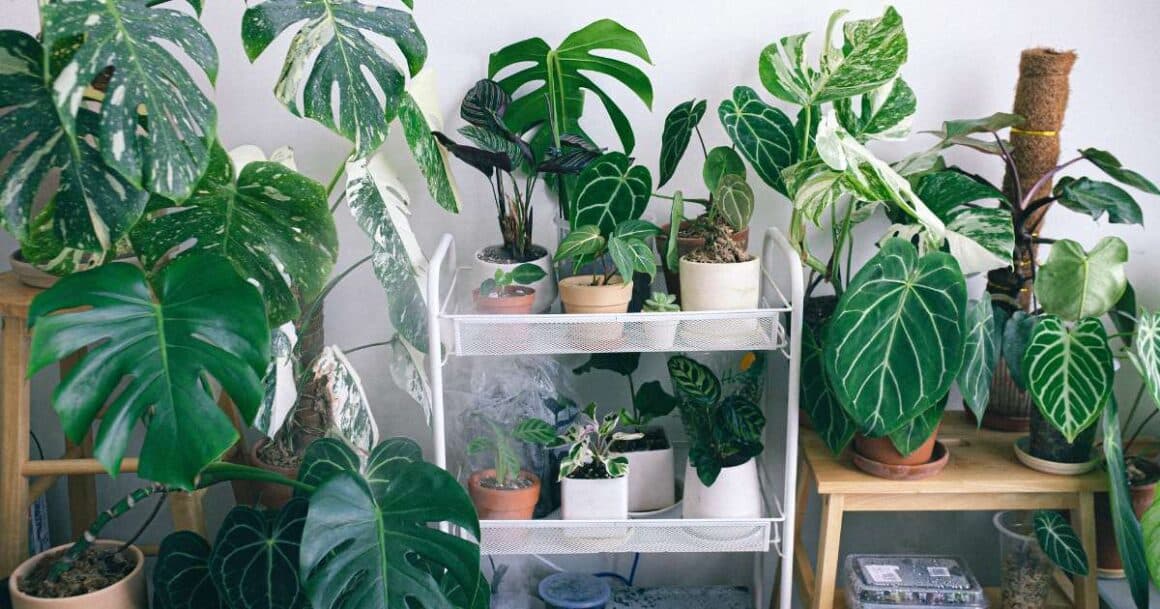
How to Increase Humidity for Plants Without a Humidifier
Misting Plants
Misting your plants with a spray bottle filled with water can help increase humidity levels around them.
Humidity tray:
Create a humidity tray by filling a tray with small rocks or pebbles and then adding water. Place your plant on top of the stones or pebbles, ensuring the bottom of the pot is not touching the water.
Grouping plants
Grouping plants can create a microclimate of higher humidity around them. You can also add a shallow tray of water in the middle of the grouping to increase humidity further.
High Humidity Rooms
Put plants in the bathroom and let the steam from the shower.
Placing your plants in high-humidity rooms such as bathrooms can be a simple and effective way to increase humidity levels around them. Bathrooms typically have higher humidity due to running water and steam from showers and baths.
Shop Humidifiers for Indoor Plants
FAQs: Best Humidifiers for plants
Q: What is the best type of humidifier for indoor plants?
A: Cool-mist ultrasonic humidifiers are generally considered the best type for indoor plants because they create mist without raising the room temperature.
Q: What is the ideal humidity level for indoor plants?
A: Most indoor plants prefer humidity levels between 40-60%.
Q: Can a humidifier be used year-round or only during certain seasons?
A: A humidifier can be used year-round if needed but may be especially beneficial during winter when indoor heating can dry out the air.
Q: How often should I clean my humidifier to prevent mold and bacteria growth?
A: You should clean your humidifier at least once a week to prevent mold and bacteria growth.
Q: What features should I look for in a humidifier for my plants?
Answer: Look for a humidifier with a large water tank, adjustable humidity settings, and a humidistat to monitor the humidity level.
Q: Can a humidifier help prevent pests in my plants?
Answer: Yes, a humidifier can help prevent pests by providing a more favorable environment for the plants and making them less susceptible to infestations.
What is the difference between a cool mist and a warm mist humidifier?
A: A cool mist humidifier releases room-temperature mist, while a warm mist humidifier releases mist that has been heated.
Q: How can I tell if my humidifier adds too much moisture?
A: Signs of too much humidity include condensation on windows and surfaces, a musty odor in the air, and mold growth.
Q: Can I use essential oils in my humidifier for my plants?
A: Yes, you can use essential oils in a humidifier, but make sure to use pure, high-quality oils and follow the manufacturer’s instructions for adding them to the water.
Q: What kind of water should I use in my humidifier for plants?
Tap Water: This is the most common choice. It’s easy and usually safe to use tap water in your humidifier. But here’s the catch – it depends on where you live. If your tap water is hard and has a lot of minerals, it might lead to a pesky problem called “white dust.” That’s the powdery residue left behind when the water evaporates. It’s harmless but can be a bit annoying.
2. Distilled Water: If you want to avoid that white dust situation altogether, distilled water is your go-to. It’s pure and free from minerals. But here’s the trade-off – it can be a tad more expensive than tap water in the long run.
3. Filtered Water: If you’ve got a water filter at home, you’re in luck. Filtered water can be a great middle ground. It’s typically lower in minerals compared to straight-up tap water.
Related Articles:
- The Best Neem Oil for Plants
- The Best Fertilizer for Indoor Plants
- How to use LECA Pebbles for Plants
- How to Make Homemade Plant Fertilizer
- How to Use Coffee Grounds for Plants
- How to Propagate Plants in Water
- The Best Easy, Fast-Growing Houseplants
- The Best Ways to Kill Fungus Gnats
- The Best Indoor Plants for Arizona
- The Benefits of a Snake Plant
Conclusion: The Best Humidifiers for Plants
So, to sum it up, we’ve explored:
- We reviewed the ideal humidity levels for plants, with most houseplants feeling cozy in the 40% to 60% range.
- The different types of humidifiers (ultrasonic humidifier and evaporative humidifier) and the pros and cons of each.
- The age-old debate of warm mist vs. cool mist humidifiers and which plant humidifier best fits your needs.
- Key factors to consider when shopping for a plant humidifier so you can make an informed decision.
- The best types of water you can use in your humidifier, from tap water to distilled, and the advantages of each.
Armed with this knowledge, I hope you’re ready to take the leap and invest in a new humidifier for your houseplants.
Your plants will thank you with vibrant foliage and a happier, greener home.
Happy gardening!
XO, Christine

I’ve been keeping it real since 1963. 🙂
I’m a child of God, a wifey, mama, grandma, full-time creative, domestic engineer, and self-care enthusiast.
I am obsessed with all things makeup and skincare and love getting my hands dirty out in the garden, my art room, or in the kitchen, whipping up something yummy for the fam.
I’m always down to chat and love collaborating with other creatives and brands alike!
Feel free to reach out anytime!










